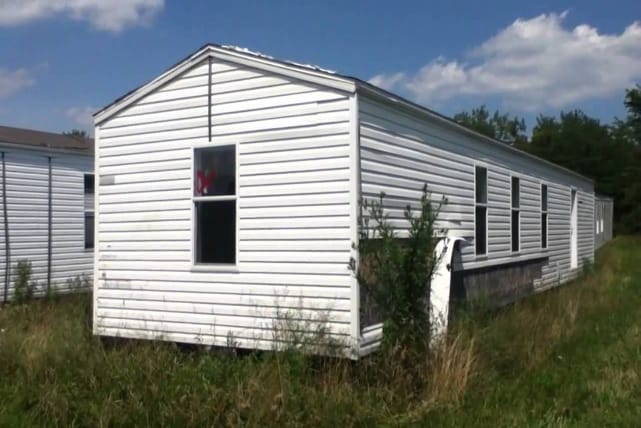(Updated December 1, 2025) Older manufactured homes can be a great investment, but only if you know how to assess the risks. Like any site-built house, a manufactured home can and will deteriorate over time if left to the elements or faulty maintenance. The key to successful ownership is knowing how to spot the Top 12 Issues—from foundation failure and roof leaks to crucial financing problems caused by missing paperwork. We provide detailed solutions below, along with links to our specialized guides that address the most expensive and time-consuming repairs.
A mobile home with problems may have various visible issues. For instance, the roof may be sagging, there may be holes or leaks in the roof, or the siding may be damaged or missing. The windows may be cracked or broken, and the door may be damaged or difficult to open and close. Additionally, the mobile home may be leaning or unstable due to foundation problems, and there may be issues with the plumbing, electrical system, or heating and cooling system. Overall, a mobile home with problems may have a rundown appearance and require significant repairs and maintenance to be habitable.
Older manufactured homes can be a great investment or a very reasonably priced place to make a home. If taken care of and maintained well, these homes can appreciate in value over time. Like any site-built home, a manufactured home can and will deteriorate over time if left to the elements or faulty maintenance.
Table of Contents
Short Answer
The most common problems we find with mobile homes can be summed up as:
- Foundations – Piers sinking, tilting and pulling away from the mobile home frame. Tie-down straps also becoming loose.
- Doors and Windows Out Of Alignment – When foundation settling occurs, it is common for mobile home doors and windows to get out of alignment where they will not close or latch properly.
- Roof – Roofs often develop leaks. This is especially true of older mobile homes that have metal rooftops.
- Leaks – Mobile homes are especially susceptible to water damage from leaks. Leaks can often occur around the perimeter of the roof, windows, and plumbing. This is especially true around sinks, toilets and tub showers. Subfloor damage can and often occurs.
- Ceilings – Mobile homes with acoustical panels instead of drywall can be especially problematic if there have been leaks. It is often extremely difficult to find matching acoustical panels. Installing them can also be problematic.
- Plumbing – Many older homes used polybutylene pipes which have been notorious for degrading from the inside out, and then bursting.
- Wiring – Wiring can be problematic if the home has had owner added additions and features where the wiring has been tapped into the original electrical panel.
- Homeowner Built Additions – Very common for a DIY type of owner to have built on a room, porch or shed. If not built properly, these can cause damage to the homes’ roof, foundation, walls, and electrical systems.
- HVAC – Over time, previous owners often ad window a/c units because the original HVAC system was not cooling and heating properly. Sorting out the original system can be expensive, but is not difficult to tackle.
- Insulation – The most problematic for insulation in mobile homes is under the floor. The home has a “belly wrap” that holds the floor insulation in place. This can often become damage and cause problems.
- Washer Drains and Dryer Vents – Often you might see these two items draining and venting directly below the home. These can be especially problematic for the foundation of the home.
- Damaged Skirting – Skirting is designed to keep the area below the home dry and critter free. Often skirting may have holes or panels missing. This allows quite a bit of havoc to occur which can damage many mobile home systems.
Foundation
Foundation or Leveling Problems
Foundation settling is a common issue, particularly in older mobile homes placed on unstable clay or expansive soil. This settling can manifest as severe symptoms throughout the home, including stuck doors, noticeable sloping floors, and diagonal cracks in the drywall. While minor issues may be fixable with shimming, major settling requires professional re-leveling and underpinning to prevent structural damage and maintain the home’s value.
➡️ Expert Deep Dive: Understanding the true financial impact and cost of repair is essential. For the national average cost breakdown, warning signs, and the three main repair methods, read our complete guide: [Link to: Fix Your Sinking Home: The Complete 2025 Cost Guide for Mobile Home Foundation Re-Leveling]. https://mobilehomefriend.com/mobile-home-common-problems/
Mobile homes are a popular housing option for many people due to their affordability and mobility. However, older mobile homes are particularly susceptible to foundation issues that can cause significant problems if left unaddressed. The foundation of a mobile home is critical for providing stability and support to the entire structure, and any issues with the foundation can lead to structural damage and safety hazards. In this context, it’s essential to understand the common foundation issues that older mobile homes may face and how to identify and fix them to ensure the safety and longevity of the structure.
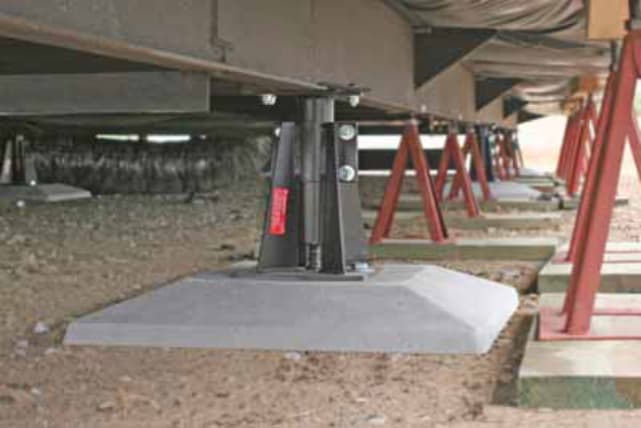
Once at the site, that steel frame underneath the home requires a foundation to securely support it and secure it to the ground. Most manufactured homes use a “pier and tie-down” system to secure the home into place and meet local codes to keep it secure and in compliance with codes and building permits.
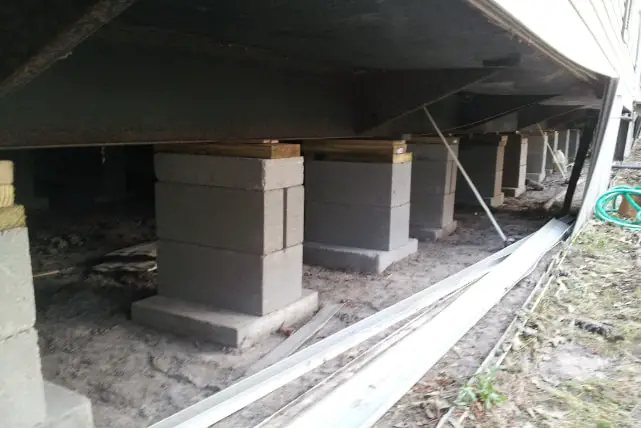
The stability of a manufactured home is only as good as the support system it rests on. As in the illustrations below, a good secure manufactured home system uses a series of piers and tie-downs to keep it secure.
Proper site preparation is a must when setting up a home originally. Mobile home sites should be graded with a small berm in the middle with the ground slightly sloping outward. This makes any water that may get under the home to run away from the home. Water pooling beneath the home is a major cause if failure with piers and tie-down systems.
PIERS – These are generally steel jacks, cinder blocks or cement pyramids that rest on a cement slab of some type. These piers must be strong enough to support the weight of the mobile home and have minimal movement over time.
TIE DOWNS – The tie-downs are a series of straps that anchor the mobile home securely down onto the foundation. They attach to the frame of the mobile home and also to secure hooks in the ground. These tie-downs give the structure the ability to withstand strong winds that might exert force against the overall structure. If the home moves after installation, the tie-downs can lose their tension and effectiveness. When this occurs, they need to be re-tensioned.
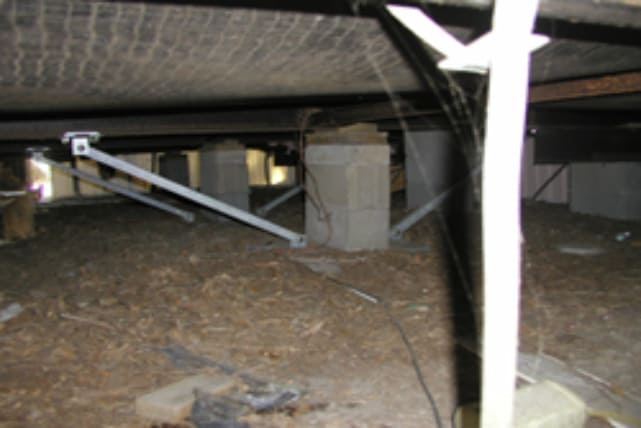
PROBLEMS – We often see the piers resting completely on the bare ground and not onto a strong and stable cement foundation. The ground may be soft in areas, it may get wet and expand and contract. Over time, the piers will sink or move causing them to lose the support they provide to the mobile home frame. When this happens, the mobile home starts to sag in certain areas, become unleveled, and cause all sorts of problems we’ll talk about further.
Often, the quick fix is to jack up the home just a bit and install wood shims to regain the support. This type of fix simply puts a small band-aid on a much larger problem. Whatever caused the pier to move or sink has not been corrected, and it will continue to do so in the future.
Making sure that each pier is properly supported is the correct fix. Properly supporting the pier is done by making sure it is sitting on a cement column or slab to prevent further sinking.
DETECTION – When walking through a mobile home, your sense of balance will help you determine if the floor sags or slopes. If it does, then you can be sure that there are foundational issues going on beneath the home. It is always wise to get under the home and inspect the piers and tie-downs to ensure they are in good condition.
SOLUTIONS – If the piers are metal and rusted badly they should probably be replaced. If they are cement piers or cinder blocks, check to make sure that they are still straight vertically. If they have tilted, chances are the foundation they are sitting on has begun to sink. If this is the case, they will need to be removed, and the cement footing replaced or repaired. The piers can then be reinstalled and shims used to level it out. Depending on the shape of each component, this can cost a few hundred dollars to $3,000 or $4,000 if they all need repair.
Be sure to check the tie-down straps and anchors and get them re-torqued if needed.
⚠️ Immediate Call to Action: Foundation issues must be addressed by certified professionals to secure financing. If you detect any sinking or shifting, see our complete guide for all costs, repair methods (including helical piers), and how to get your home re-leveled:
View the Mobile Home Foundation Repair Cost Guide
Doors And Windows Out Of Alignment
Mobile homes, like any other structure, experience wear and tear over time due to environmental factors such as weather, humidity, and temperature fluctuations. One of the common issues that older mobile homes face is the misalignment of doors and windows. This happens because the materials used to construct mobile homes, such as lightweight metals and vinyl, can expand and contract in response to changes in temperature and humidity. As a result, the frames that hold doors and windows in place can warp or bend, leading to misalignment issues. Additionally, frequent movement and settling of the mobile home can also contribute to misalignment. These issues can lead to drafts, energy inefficiency, and security concerns, making it crucial to address them promptly.
DETECTION – When you walk into a home, take a mental note on how the floor feels and if there are quite a few squeaks. Open and close every exterior and interior door and window. Check to see if the doors all latch properly and if they are square in their frames. With windows, see if they move smoothly in their tracks without binding.
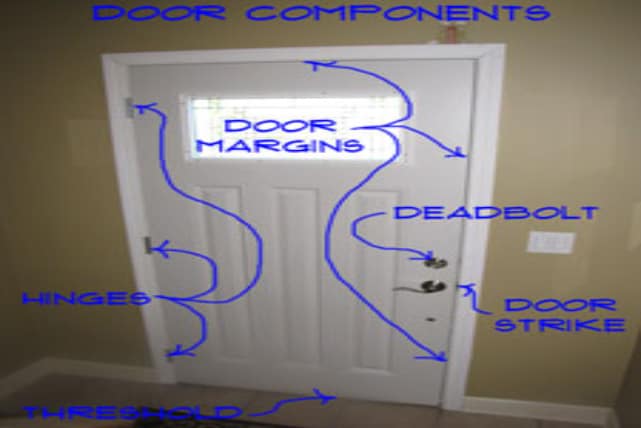
SOLUTION – If the doors and windows seem to be out-of-alignment, the first thing towards a solution is to get the foundation repaired as per the discussion in that section. Once the home has been re-leveled, then check the doors and windows again. If the problems persist, then getting proper alignment can be done by a combination of things. First, you may be able to adjust the hinges to the door. Also, you may need to removing the trim around the door or window and use wood shims to adjust the door or window until it latches or moves smoothly.
Once the foundation has been repaired, adjusting the doors and windows is a relatively easy process that can be done by a handyman and should not be very costly.
Roof
The roof is a critical component of any home, and mobile homes are no exception. Older mobile homes are particularly prone to roof problems due to several reasons. Firstly, the materials used in older mobile homes, such as metal and shingle roofing, are not as durable as modern roofing materials. As a result, they may develop leaks, cracks, or rust over time, leading to water damage and other issues. Secondly, the installation of the roof may not have been done correctly, leaving gaps or uneven spots that allow water to penetrate. Thirdly, older mobile homes may have a flat or low-slope roof design, which tends to accumulate water, debris, and snow more easily, leading to additional wear and tear. Finally, older mobile homes may not have received regular roof maintenance, such as cleaning gutters, replacing worn-out shingles, or resealing seams, making them more susceptible to problems. Addressing these issues promptly is crucial to maintain the structural integrity of the home and prevent further damage.
ASPHALT SHINGLE – Most manufactured homes built since the 1980s have built-up asphalt shingle roofing systems. These are much the same as any site-built home. Asphalt shingle roof systems work great and are long-lasting up to 20 to 30 years.
PROBLEMS – Over time, the shingles will succumb to the weather. They will dry out and start curling around the edges. When this happens, they are no longer able to seal out the water and will often leak.
SOLUTION – Inspect the roof to determine the shape of the shingles. If they are in a state of decay, it will likely cost $4,000 to $6,000 to have them removed and replaced with a new roof.
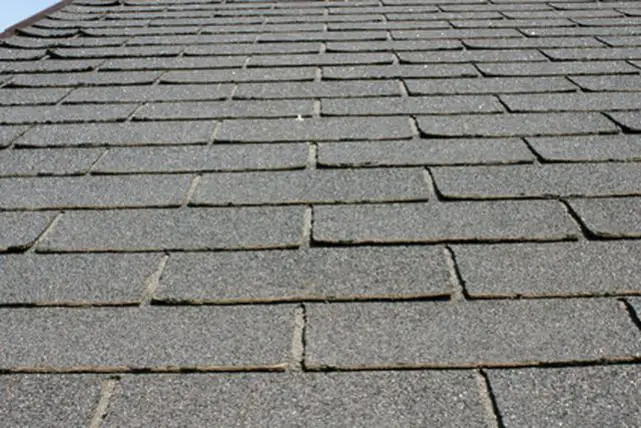
ROLLED STEEL ROOFING – Many older mobile homes built in the 1980’s and before have “rolled steel roofing”. These are galvanized sheets of steel that cover the top of the home. They have rolled seams that hold the sheets to each other, and then they are secured to both sides of the home and sealed to keep the water out.
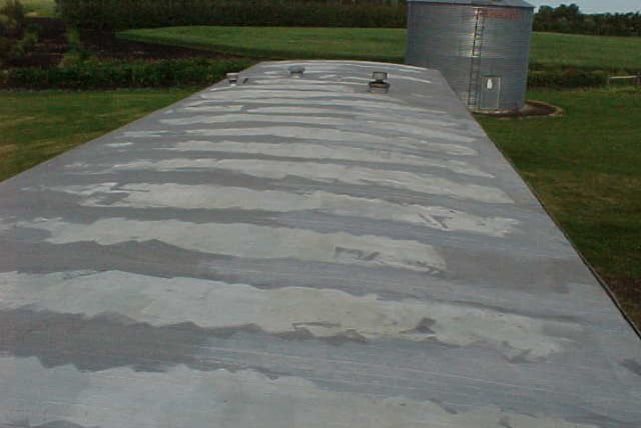
PROBLEMS – Over time these sheets of steel can begin to rust even though they are galvanized. The seams between the sheets can also begin to leak as well as around the perimeter of the home. Climb up on the roof and take a look. Focus on the seams between the sheets and especially around the perimeter.
SOLUTION – There are many types of elastic roof coatings and sealers that can be purchased at your favorite big-box home store. These can be easily applied with paint brushes and rollers. The cost of this solution will be about $200.
There are quite a few people who also put a “rubber roof” over the steel. This is a far more expensive solution and can cost thousands, but would be recommended if the rolled steel roof panels are badly damaged.
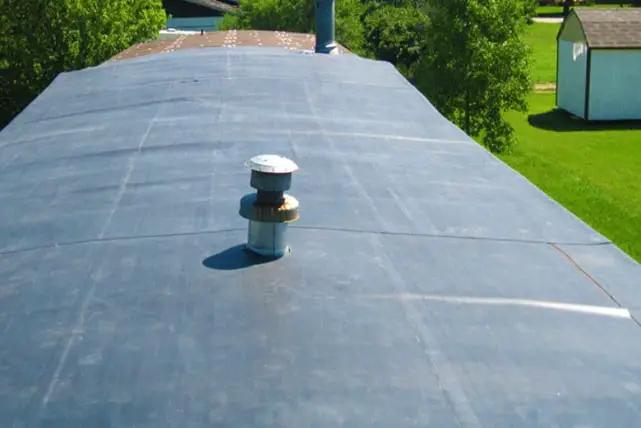
Leaks
Water leaks are a common problem in older mobile homes and can cause significant damage if left unaddressed. Several factors contribute to this issue. Firstly, older mobile homes may have outdated or damaged plumbing systems, such as corroded pipes or leaking faucets, that can cause water damage. Secondly, as mobile homes age, the materials used in the walls, roofs, and windows may deteriorate, allowing water to seep through cracks or gaps. Thirdly, older mobile homes may not have proper ventilation systems, leading to increased humidity and condensation, which can cause mold and water damage. Fourthly, improper installation or maintenance of roofing and siding can cause water to penetrate into the home. Finally, older mobile homes may not have been built to withstand extreme weather conditions, making them more susceptible to leaks during heavy rain or snow. Regular inspections and maintenance can help prevent water leaks and mitigate any damage caused by water infiltration.
With roof problems, leaks often develop and cause water damage to ceilings, walls and floors. Water is pretty much the number one enemy against any structure, mobile or site-built. Anytime a leak is detected it is important to get it corrected right away before further expensive damage occurs.
In addition to the roof leaking, windows may also leak. When this happens, wall and floor damage can be the result; weakening the structure.
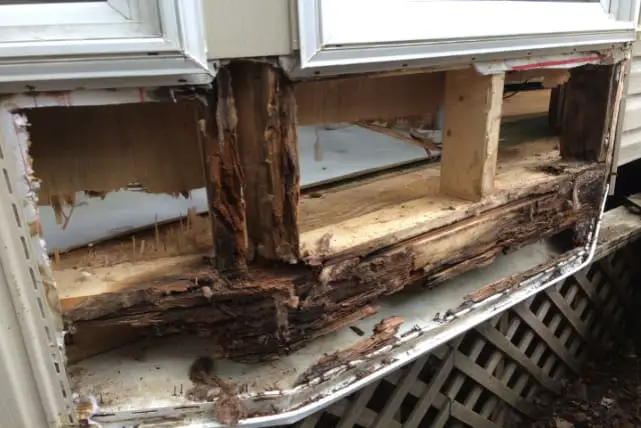
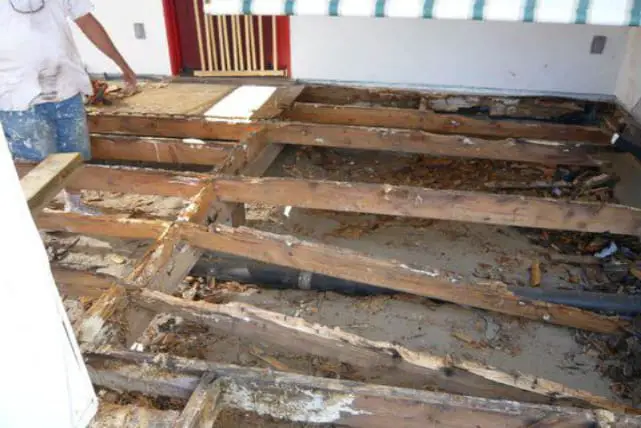
PROBLEM – If leaks are not repaired, wood rot can occur rapidly. Remember, that the rot that occurs is in the actual structure of the home. Wall studs and floors. I’ve seen homes that were pretty much just “tear-downs” because small leaks were ignored.
DETECTION – Visually inspect each window from the exterior and the interior. Look closely at the window seals to see if there is any rot visible. If there is surface damage or rot, the damage could be far worse inside the wall. Walk through the home and push hard on any exterior wall. You are checking for movement. If the wall is easily moved and wiggles, there is likely significant wood rot inside the wall.
Next, walk through the home and step on every bit of flooring that you can. Especially around any exterior window or near any plumbing fixture. What you are looking for are soft spots in the floor. Leaks can easily damage the wooden sub-floor. I’ve purchased mobile homes where my foot has gone through the floor when I perform this inspection. Soft spots in the floor are almost always caused by water leaks.
SOLUTION – Window leaks can be the most difficult to deal with. Why? If you can tell the leak has been significant, you will need to remove the wall surface inside, or the siding on the exterior in order to repair. Once the structure around the window is exposed, you can evaluate the extent of the wood rot and what must be replaced in order to correct the damage.
Soft spots in floors are typically a much easier fix than tearing apart the walls. Repairs of sub-flooring is not too difficult or expensive. There are plenty of videos and specific posts available on how to correct both rot from leaking windows and soft spots in the floors. When evaluating a mobile home for purchase, you need to be aware of the extent of the repairs that will need to be made.
Ceilings
As mentioned throughout this post, water can cause all sorts of damage to every part of a structure. Leaks occurring from the roof can cause ceiling damage. Years ago, many older homes were built with long, narrow acoustical tiles for the ceilings. Many homes built since the 1980s and forward often have drywall for ceilings.
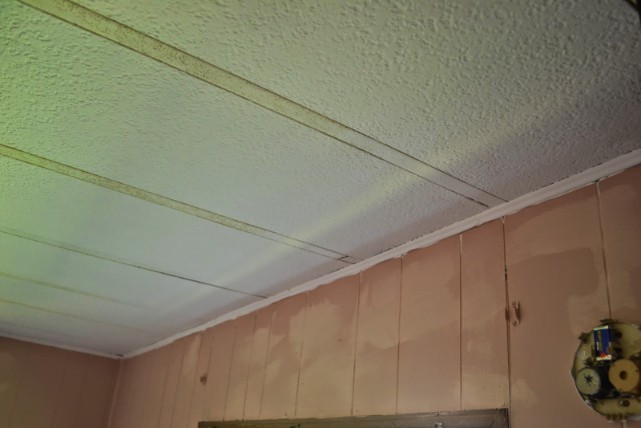
PROBLEM – Ceiling materials are simply cosmetic. The roof structure is not. If leaks in roofing go undetected, the trusses above the ceiling can become damaged and warp and or rot. Ceiling materials, (drywall or acoustic) is far easier to repair than warped or rotted trusses.
DETECTION – Walk through the home and look over the entire surface of the ceilings. Pay special attention to the areas where the ceilings meet the exterior walls. If leaks are present, acoustical tiles will discolor and be easy to detect a leak. Drywall ceilings can be a bit trickier. With drywall, look at the condition of the paint. Loose or bubbling paint on the ceiling drywall is often the sign of a leak.
SOLUTION – Like anything, repairs can be made, but the cost might vary widely.
TRUSS WARPAGE OR ROT – If the ceiling leak has been a long-term problem and there is truss rot or warpage, you probably want to have a roofing expert look at the problem. I’ve purchased a few homes that have had warped roof trusses. In these scenarios, I’ve taken out the drywall or acoustical panels to bare the roof structure above. Warped or rotted pieces of the truss can be repaired by removing and replacing the bad sections. This can be expensive as you will usually need a framer to do the work unless you have experience yourself.
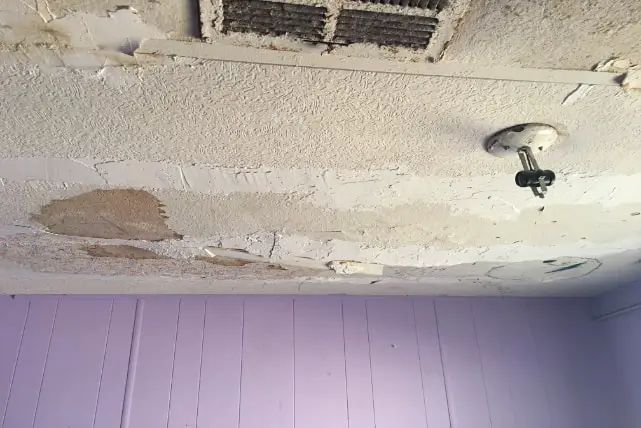
ACOUSTICAL PANELS – Slight water staining can occur to these panels and they are not damaged enough to replace. If it is just staining, the panels can be primed with “Kils” primer and then repainted.
Acoustical panels are usually about 16” wide and run the width of the home. Replacing these panels can go beyond just a headache. They can be a real pain in the butt.
- First, finding a matching panel can be difficult, if not impossible.
- Second, installing them can be very difficult. These panels are placed during mobile home construction before the interior walls are put in.
When I’ve had rooms where the acoustical panels are damaged beyond a primer and paint, I have removed them throughout the room, and replaced the ceiling with drywall instead. I have found that this is an easier and less costly fix than working with the panels.
DRYWALL – This is a much easier fix. Drywall repairs are simple, inexpensive and there are plenty of tradespeople who can do this type of repair.
Plumbing
Mobile homes are more susceptible to plumbing issues than traditional homes due to their unique design and construction. Firstly, mobile homes have smaller plumbing systems, which can lead to clogs, blockages, and leaks more easily. Secondly, mobile homes may have outdated or inferior plumbing components that are prone to wear and tear, such as thin or corroded pipes, substandard fittings, or low-quality fixtures. Thirdly, mobile homes are built on a chassis that is subject to constant movement and settling, which can cause stress and strain on the plumbing system, leading to cracks or leaks. Fourthly, mobile homes are often exposed to extreme temperatures, which can cause freezing and bursting of pipes during the winter months. Finally, mobile homes may not have proper ventilation or insulation, leading to increased humidity and condensation, which can cause mold and water damage. Regular maintenance and inspections of the plumbing system can help prevent these issues and ensure that the system is functioning correctly.
Plumbing issues are common in any older structure and mobile homes are not an exception. Fortunately, fixing plumbing in a mobile home is far easier than it is in a site-built home. One of the biggest issues with plumbing was the use of Polybutylene plumbing material.
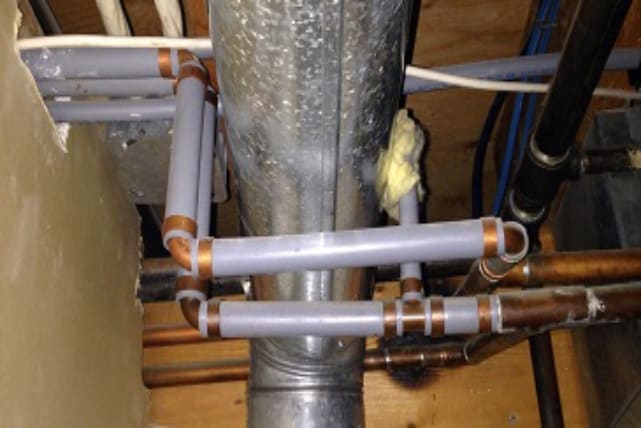
POLYBUTYLENE PIPES
This material was also called “PB” among the trades people. It was used for residential plumbing from the early 1980s through the mid 1990s. When first released this type of pipe was seen as “the future” of plumbing because of its low cost and its ease of installation. This type of pipe was used throughout the residential plumbing world at the time, but was especially prevalent in the mobile home world.
DETECTION – Polybutylene piping is usually gray, but may also be blue or black. It also had copper-colored band connections. Look for a stamping on the pipe of “PB2110”.
PROBLEM – The issue with polybutylene piping is that chlorine and minerals found in the water supply would cause the piping to deteriorate from the inside out. To look at the exterior of the piping, it would look fine; although it could be disintegrating on the inside.
Through the 1980s, hundreds and then thousands of pipe failures occurred causing millions of dollars in property damage. Class action lawsuits were filed claiming defective materials and installation. The manufactures never acknowledged that the material was defective. They did however agree to fund a class action settlement to appease homeowner claims. The settlement was just under a billion dollars. The time for filing a claim as part of this settlement ended in 2007.
Because of polybutylene’s known problems, any property still using this piping material will take a hit to its marketable value. It may also cause insurance premiums to be higher, or insurance to be denied altogether.
SOLUTION – Mobile homes are built atop a frame with a crawl space underneath. They are also only one level. This makes the replacement of plumbing far easier than it might be in a site-built home that may be multiple stories or built on a slab foundation. We have successfully been able to re-plumb an entire mobile home with modern Pex piping for less than $1,000.
Wiring
Mobile homes often have a higher risk of wiring issues than traditional homes due to their unique design and construction. Firstly, mobile homes may have outdated or inferior wiring components that are prone to wear and tear, such as old wiring, substandard outlets, or low-quality fixtures. Secondly, mobile homes are built on a chassis that is subject to constant movement and settling, which can cause stress and strain on the wiring system, leading to loose or damaged wires. Thirdly, mobile homes are often exposed to extreme temperatures, which can cause wires to expand and contract, leading to breaks or short circuits. Fourthly, mobile homes may not have proper ventilation or insulation, leading to increased humidity and condensation, which can cause electrical issues. Finally, mobile homes may have been modified or repaired by unqualified individuals, leading to improper wiring installations or repairs. Regular inspections and maintenance of the electrical system can help prevent these issues and ensure that the system is functioning correctly.
Generally wiring and electrical panels installed at the factory generally hold up well over time. The problem doesn’t usually have to do with the manufactured original wiring, but with homeowner modifications over time.
DETECTION – With mobile homes, owners will often build add-on structures to the original home. This may be an extra room or a shed off the side of the home. If the mobile home you own or are considering purchasing has add-ons, look to see how professional is the build quality? Many of these add-on structures are DIY weekend projects by a previous owner, including the electrics.
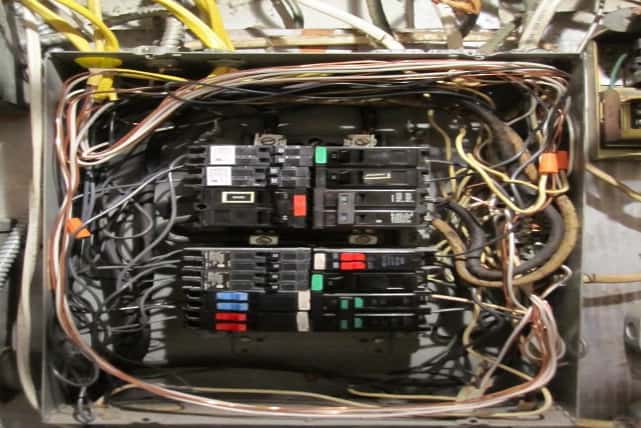
PROBLEM – The wiring used for these projects often differs from the type of wiring used inside the original home. also, many times the wiring is brought into the main electrical panel for the home. This wiring is often tied into the original circuitry which wasn’t designed for the additional electrical load. Look closely at the electrical panels for the home to determine whether the electrics were sorted properly. Faulty electrics are a major source of fires in structures. This is something you’ll want to make sure is properly done.
SOLUTION – If the original electrical panel has been tampered with over the years, it is wise to have a professional electrician sort it out. This may involve adding a second panel to support the electrics of any homeowner modifications that were done over the years. This can cost anywhere from a few hundred dollars to a few thousand dollars depending upon the extent of the tampering.
Homeowner Built Additions
Homeowner-built additions on mobile homes are often poor quality due to several factors. Firstly, mobile homes are built to specific codes and regulations that must be followed for safety and structural integrity. Homeowners who attempt to add on to their mobile homes without proper knowledge or permits may not adhere to these regulations, leading to substandard workmanship and unsafe conditions. Secondly, homeowner-built additions may not be designed to accommodate the unique construction of mobile homes, such as the weight distribution or the materials used, leading to structural issues. Thirdly, homeowner-built additions may not be properly integrated into the existing home, leading to water infiltration, electrical issues, or other problems. Fourthly, homeowner-built additions may not be built to withstand extreme weather conditions, which can cause additional wear and tear. Finally, homeowner-built additions may not be aesthetically pleasing or functional, detracting from the overall value and appeal of the home. It is essential to hire qualified professionals and obtain the necessary permits and inspections when making additions or modifications to a mobile home.
Site-built additions are common for a mobile home structure. These can include anything from awnings and porches to room add-ons and sheds. Many of these are built professionally without causing any problems for the mobile home. Yet, others are weekend DIY projects and may need sorting out.
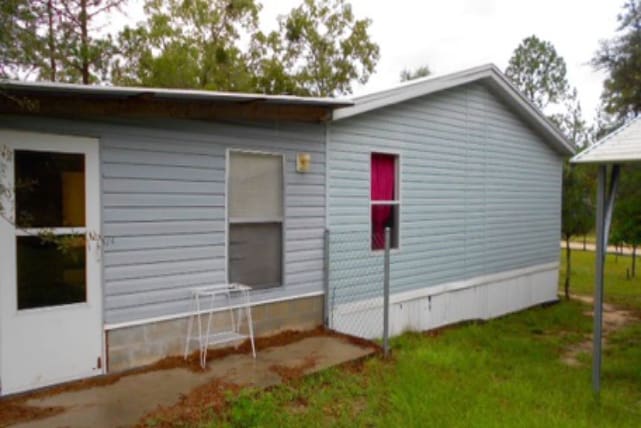
DETECTION – Quite simple, are there any additions built onto the mobile home? Remember that this includes covered awnings and porches.
PROBLEM – HUD is very specific that the frame and outer walls to the mobile home were only designed to carry the load of their own weight. Any structure that is adding weight to the walls for frame of the mobile home would not be up to HUD standards.
Covered awnings and porches are the most common additions that you’ll run across with mobile homes. Most professionally installed covered awnings are made of very lightweight aluminum. These will usually attach to the roof of the mobile home on one-side and have their own support posts on the other. These materials are of very light weight and specifically designed for use with the mobile home.
Problems occur when heavier structures are built using typical 2×4 stick built structures that tie-into the outer wall of the mobile home. If these structures add weight to the outer wall this puts added stress on the frame which can cause it to sag under the weight. Such structures, be it a shed, room addition or porch structure, needs to have its own support system transferring its own weight to the ground without using the mobile home structure.
SOLUTION – If add-ons exist, look to see how the weight transfer next to the mobile home as designed. There should be load-bearing support posts outside of the mobile home to carry the weight of the structure down to the ground. If the proper load transfer system is not in place, this must be built to solve the problem.
HVAC
Mobile homes are prone to specific HVAC (heating, ventilation, and air conditioning) problems due to their unique design and construction. Here are some of the most common HVAC problems that mobile homes may experience:
- Improper installation: HVAC systems that are not installed correctly can cause a range of issues, such as reduced efficiency, increased energy costs, or inadequate heating or cooling.
- Poor ventilation: Mobile homes may not have proper ventilation systems, leading to increased humidity, mold growth, and respiratory issues.
- Leaky ducts: Leaky ducts can cause reduced efficiency, uneven heating or cooling, and increased energy costs.
- Inadequate insulation: Mobile homes may not have proper insulation, leading to heat loss in the winter and heat gain in the summer, increasing energy costs.
- Outdated equipment: Older HVAC systems may not be as efficient or effective as modern systems, leading to increased energy costs and reduced comfort.
- Lack of maintenance: Mobile homes may not receive regular HVAC maintenance, such as filter replacement, cleaning, or inspection, leading to reduced efficiency, increased energy costs, and potential breakdowns.
- Thermostat issues: Malfunctioning or improperly calibrated thermostats can cause HVAC systems to operate inefficiently or not at all.
Addressing these HVAC problems promptly and with the help of qualified professionals is crucial to maintaining a comfortable and healthy living environment in a mobile home.
It seems that every mobile home we have purchased, for investment or otherwise has had issues with the HVAC system. From one to multiple issues numbered above. To make the home comfortable for living, a good system to keep the home warm in winter months and cool throughout the hot season is a must.
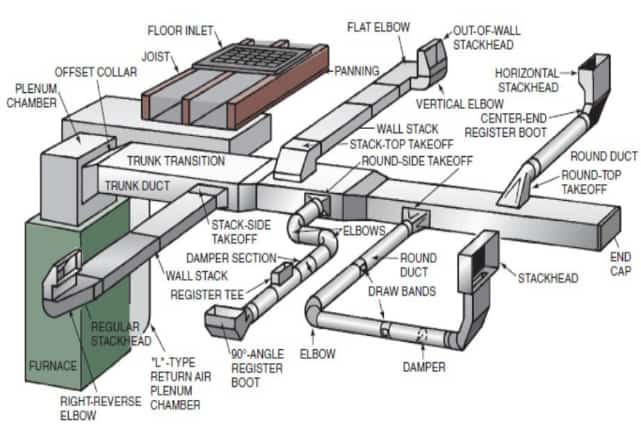
DETECTION – When I walk up to a mobile home, I always look around the house to see if there are any window A/C units hanging out. Often I find more than one of these. This alerts me right away that either there isn’t a functional central unit in the home, or if there is, it isn’t operating properly.
PROBLEM – When manufactured homes are built, the typically have an furnace and air handler unit built into a closet inside the home. This feeds the air down underneath the home to a central ducting system that distributes the air through floor vents in each of the rooms.
In homes that are usually more than 20 years old, I find that the original air-handling unit inside the home is in poor condition, or is not working at all. I also find that the sheet metal ductwork underneath the home has developed air leaks at the connection junction to the air handler as well as the various floor vents throughout the home. All of this causes inefficiencies for the HVAC system.
To try to get the system working adequately, homeowners will often just put a small window A/C unit in the rooms that are having problems.
SOLUTION – Often, the ductwork may need to be repaired, or in the worst case scenario, replaced. Follow this link to a our blog post on “How Much Does It Cost To Replace Ductwork In A Mobile Home?”.
Make sure that the ductwork is in good condition and clear of debris. Over the years, debris can accumulate inside the ductwork impeding air flow. It is a good idea to have the ductwork cleaned. Also, check on the condition of each vent register throughout the home. They should be in good condition and not bent or permanently closed causing reduced air flow to that room.
In most cases, we end up replacing the existing system with a complete exterior HVAC system using the original ductwork to the home. We remove the original closet located air handler (which actually increases closet space in the home as an added benefit). We buy a heat pump / air handler combo unit that rests on the ground outside the home. The ductwork for this feeds through the skirting and ties into the original ducts underneath the house.
The reason we do this is that we can get a great unit that is either refurbished or a a newer repossessed unit. We make close connections with a few HVAC professionals who usually have a great unit that we can purchase and install for less than $2,000.
Insulation
In a mobile home, insulation is found in the attic, outer walls and under the floor. The under-floor insulation is held in by what is known as the “belly wrap”. Insulation standards pretty much mirror those for site-built homes with R-30 or higher in the ceilings, R-13 in the walls. The floor insulation is usually R-15 to $-30.
Many older pre-HUD mobile homes have far less insulation R values than those noted above. Often, with an old mobile home, the limiting factor for insulation is the thickness of the cavity that holds the insulation.
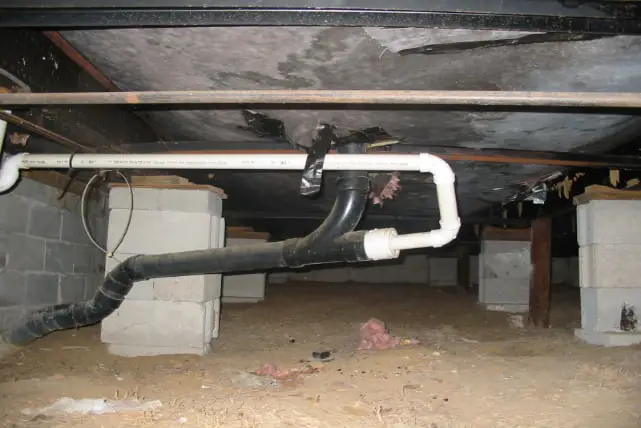
PROBLEM
The belly-wrap. This is where most insulation problems occur. The under-floor insulation, as noted above, is held in place by a belly-wrap. This is usually a heavy gauge plastic sheeting that is stapled into the floor joists and keeps the insulation from falling out. This helps keep out moisture as well as insects and other rodents from entering.
Over time, the belly wrap often becomes damaged. Plumbing repairs often require cutting holes in the plastic sheeting. Many times these holes are never resealed, or just taped up; which typically comes loose over a short period of time.
When this happens, animals which might get under the homes through gaps in the plastic often get into the insulation to use for nesting material. They also might just have a field day spreading it around under the home; just for entertainment.
Also, check for low spots hanging. This can be indication of plumbing leaks. The insulation gets heavy with water and sags down.
SOLUTION
Repair any missing insulation and belly-wrap underneath the home. This can be done by taking new plastic sheeting and spreading it over a much larger area than the damaged part. Tape it into position.
Then, take 1 x 2 lumber and screw it securely into the floor joists over the plastic sheeting where the new wrap overlaps the old wrap. Make a perimeter around the repaired area with the new boards. This will assure that the new and old areas of belly wrap are property secured to each other and to the home.
Washer Drains and Dryer Vents
Mobile homes may experience specific problems with washer drains and dryer vents due to their unique construction and design. Here are some of the most common issues:
- Clogs: Mobile home washer drains and dryer vents can become clogged more easily than those in traditional homes due to smaller pipe sizes, less slope, and longer distances between fixtures and the main drain. Clogs can cause backups, slow draining, and potential flooding.
- Improper installation: Washer drains and dryer vents that are not installed correctly can cause issues such as leaks, inefficient operation, and potential hazards.
- Material incompatibility: Mobile home washer drains and dryer vents may use different materials than those in traditional homes, such as flexible plastic hoses instead of rigid metal pipes. These materials may be more prone to damage, wear, and deterioration, leading to leaks or blockages.
- Ventilation: Mobile homes may not have proper ventilation for the washer and dryer, leading to increased humidity, mold growth, and potential fire hazards from overheating.
- Lack of maintenance: Mobile home washer drains and dryer vents may not receive regular maintenance, such as cleaning or inspection, leading to reduced efficiency, increased energy costs, and potential breakdowns.
It is essential to address these issues promptly and with the help of qualified professionals to ensure the safe and efficient operation of washer drains and dryer vents in a mobile home.
I find it common to see washers draining directly to the ground underneath the home, as well as the dryer vents also just venting to the crawl space.
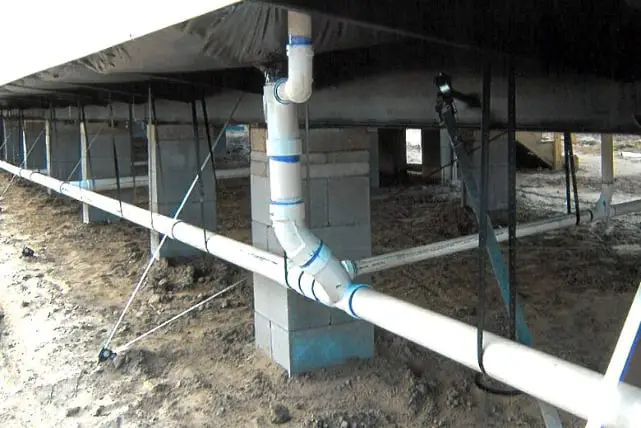
PROBLEM
If the washer drains to the ground, this can cause lots of water to soften the earth underneath the home. This can cause the piers of the foundation to sink, tilt, and pull away from the home. In such a case the home can become un-level and cause all the problems stated in the section on foundation issues. Mold also becomes a major issue with the ground being constantly wet.
Likewise with a dryer, the crawl space will be saturated with moisture and can cause mold issues. The space will also become covered with lint that can become a fire hazard.
SOLUTION
Make sure to tie the washer plumbing line into the main sewer line. The dryer venting should be run through the skirting to the outside.
Damaged Skirting
Skirting is the material that encloses the underside of a mobile home, providing insulation, ventilation, and protection from the elements. When skirting becomes damaged or deteriorated, it can cause several issues for a mobile home. Here are some of the main reasons why damaged skirting is such an issue for mobile homes:
- Increased energy costs: Skirting helps to insulate a mobile home, preventing heat loss in the winter and heat gain in the summer. When skirting is damaged, it can lead to increased energy costs as heating and cooling systems work harder to maintain a comfortable temperature.
- Pest infestations: Damaged skirting can provide entry points for pests such as rodents, insects, or snakes, which can cause damage to the structure, wiring, or plumbing of a mobile home.
- Water damage: Skirting helps to protect the underside of a mobile home from moisture and water damage. When skirting is damaged or missing, water can enter the crawl space, causing rot, mold growth, and structural issues.
- Aesthetics: Skirting helps to improve the appearance of a mobile home, covering up the crawl space and giving the home a more finished look. Damaged skirting can detract from the appearance and value of a mobile home.
- Safety hazards: Damaged skirting can create tripping hazards or unstable foundations, potentially causing injury to residents or visitors.
It is essential to address damaged skirting promptly and with the help of qualified professionals to prevent these issues and maintain a safe and comfortable living environment in a mobile home.
Skirting is second only to the roof when safeguarding a mobile home. Financial institutions require a mobile home to be fully skirted as a condition to put financing on a mobile home.
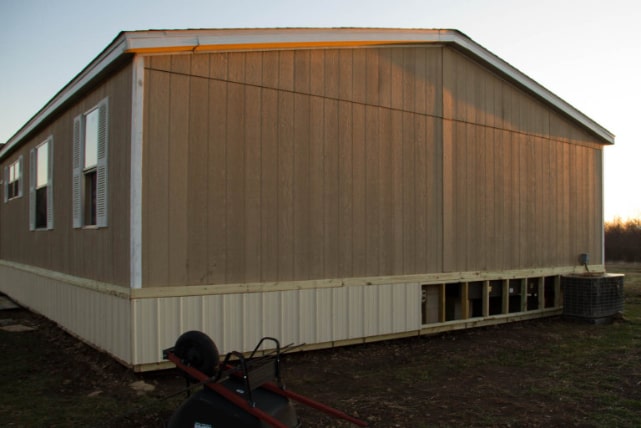
PROBLEM
Skirting comes in all types from cement blocks to wood, aluminum or fiberglass panels. Skirting keeps the elements out of and away from the underbelly of the home.
Animals quickly discover holes in skirting and enter the crawl space to nest or scavenge for materials. Also, moisture can easily enter the crawl space under the home through gaps in the skirting. As noted before, this can cause foundation issue.
SOLUTION
Repair any damage skirting quickly to prevent problems that can occur with animals and the elements.
Expert Tip: Missing Paperwork — If you cannot locate the HUD Data Plate or the VIN on the chassis, your home cannot be appraised or financed. This issue must be resolved immediately. Read our full guide on where to find your mobile home’s VIN and how to get replacement documentation to avoid loan delays.
The Difficulty of Insuring an Older Home
While not a physical problem with the structure itself, insurance difficulty is one of the biggest hidden financial issues with aging manufactured homes. Standard homeowner policies (like HO-3) are typically not available for manufactured housing, requiring owners to purchase specialized HO-7 policies or, for older homes, high-risk policies.
The 3 Major Insurance Pain Points:
- The 1976 HUD Standard: Many insurers will refuse to cover homes built before June 15, 1976, making these pre-HUD homes cash-only transactions or forcing owners into very expensive specialty plans.
- Foundation and Skirting: Insurance companies require the home to be secured and skirted. If your foundation is shifting (Issue #1) or your skirting is damaged (Issue #12), your coverage could be invalidated or non-renewable.
- Personal Property (Chattel) vs. Real Property: The type of loan you have dictates insurance. Homes financed as personal property (chattel loan) often have different insurance requirements than those financed as real property (mortgage), adding complexity.
Action: Always get an insurance quote before committing to buying an older home. If a major national carrier won’t touch it, you are looking at much higher long-term holding costs.
Related Questions
Missing VIN and Data Plate
Expert Tip: Missing Paperwork — If you cannot locate the HUD Data Plate or the VIN on the chassis, your home cannot be appraised or financed. This issue must be resolved immediately. Read our full guide on where to find your mobile home’s VIN and how to get replacement documentation to avoid loan delays.
Financial Valuation and Resale Potential
The biggest issue with older homes is often valuation—lenders see them as higher risk. To maximize your resale price and attract standard mortgages, you must be able to prove the home is real property.
Critical Resource: Don’t guess the price. Learn how lenders and appraisers value a mobile home. To qualify for a low-interest 30-year mortgage, the home must meet strict standards. We detail the path to financing success here: How to Qualify for a Mobile Home FHA Loan.
What Should You Look For When Buying A Used Mobile Home?
- Buy a mobile home that built after the HUD standards went into place. June 15, 1976. These homes are built to much higher standards for all levels of construction from framing and insulation to plumbing and electrical.
- Have a home inspection done by a professional that is familiar with mobile homes. This is the cheapest insurance you can buy for making sure you know the issues of the home before making the purchase.
- The mobile home should be in a location that you are happy with, whether it is in a park or on its own lot. Yes, mobile homes can be moved, but it is VERY expensive to do so.
Can I Repair My Mobile Home Myself?
One of the great things about owning a mobile home is that there are many things that a typical DIY oriented individual can do. Most everything is more easily accessed in a mobile home; especially the plumbing underneath.
Keep in mind that often, parts on a mobile home can be unique to mobile homes. This is especially true when it comes to plumbing and electrical. There are plenty of sites online that specialize in mobile homes and parts. Most major metro areas also have storefronts that specialize in the parts you will need.
To successfully buy or own a mobile home, you must treat three things as gospel: the Value (resale potential), the Structure (foundation), and the Paperwork (financing). Always consult our detailed guides to navigate the most complex issues:
- The 5 Requirements to Qualify for an FHA Mortgage
- Complete Guide to Mobile Home Foundation Repair Costs
- The Ultimate Guide to Finding Your HUD Tag and VIN
“Written by a mobile home investor and real estate professional with over two decades of experience diagnosing, renovating, and selling manufactured homes.”

